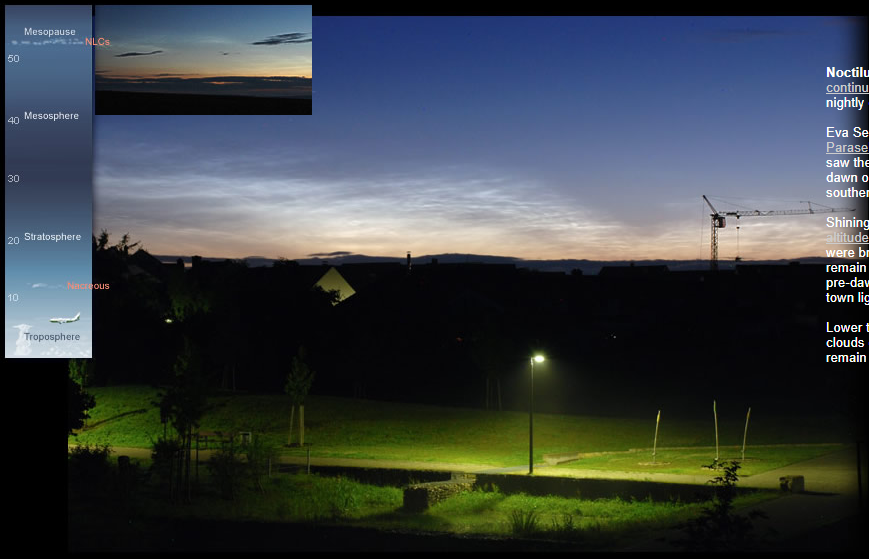NLCs shine again over Europe
NLCs Illuminate the European Night Skies Once Again
Noctilucent clouds (NLCs), also known as polar mesospheric clouds, have been captivating observers with their ethereal glow in the night skies over Europe. These mesmerizing phenomena have recently been spotted by Eva Seidenfaden from the Paraselene optics site in Trier, southern Germany, before dawn on July 4th. The NLCs, shining in the high altitude sunlight, were so luminous that they remained visible against the backdrop of the pre-dawn sky and the town lights.
NLCs are unique cloud formations that occur in the Earth's mesosphere, the layer of the atmosphere located between 50 and 85 kilometers (31 to 53 miles) above the surface. Unlike most clouds that form in the lower parts of the atmosphere, NLCs are composed of ice crystals rather than water droplets. These ice crystals form around meteoric dust particles, providing a surface for water vapor to freeze upon. The resulting clouds appear as delicate, wispy structures that shimmer in shades of blue and silver.
One of the distinguishing features of NLCs is their altitude. These clouds reside at the edge of space, where they can be found at heights of approximately 76 to 85 kilometers (47 to 53 miles) above the Earth's surface. Their elevated position allows them to catch sunlight even after sunset, creating a stunning display of nocturnal luminescence. The phenomenon is particularly visible during the summer months in the polar regions and at higher latitudes.
While NLCs provide a captivating spectacle for skywatchers, they also serve as indicators of atmospheric conditions. Scientists study these clouds to gain insights into changes occurring in the upper atmosphere. NLCs are believed to be influenced by factors such as temperature, humidity, and atmospheric dynamics. By monitoring the frequency and characteristics of NLC occurrences, researchers can better understand the complex interactions between the lower and upper layers of the atmosphere.
Observing NLCs can be a challenging endeavor due to their high altitude and the specific conditions required for their formation. However, advancements in technology have made it easier for enthusiasts and researchers to document these elusive clouds. The emergence of digital photography and social media platforms has allowed individuals to share their NLC sightings with a wider audience, fostering a sense of community among skywatchers.
In addition to their scientific significance and aesthetic appeal, NLCs also hold implications for climate research. Some studies suggest that changes in the Earth's upper atmosphere, including variations in NLC frequency and intensity, could be linked to climate change. By studying these clouds and their behavior, scientists hope to unravel the complex interplay between atmospheric processes and our changing climate.
It is important to note that while NLCs have been observed more frequently in recent years, their exact cause and underlying mechanisms are still subjects of ongoing research. The increased visibility of NLCs could be attributed to factors such as improved observation techniques, heightened awareness among observers, or genuine changes in atmospheric conditions. As scientists continue to investigate this captivating phenomenon, the allure of NLCs shines brightly over the European night skies, captivating both seasoned astronomers and casual stargazers alike.

Noctilucent Clouds continue to be visible nightly over Europe.
Eva Seidenfaden, Paraselene optics site, saw these NLCs before dawn on 4th July at Trier, southern Germany.
Shining in the high altitude sunlight they were bright enough to remain visible against the pre-dawn sky and the town lights.
Lower tropospheric clouds (inset image) remain dark.
Note: this article has been automatically converted from the old site and may not appear as intended. You can find the original article here.
Reference Atmospheric Optics
If you use any of the definitions, information, or data presented on Atmospheric Optics, please copy the link or reference below to properly credit us as the reference source. Thank you!
-
<a href="https://atoptics.co.uk/blog/nlcs-shine-again-over-europe/">NLCs shine again over Europe</a>
-
"NLCs shine again over Europe". Atmospheric Optics. Accessed on November 26, 2024. https://atoptics.co.uk/blog/nlcs-shine-again-over-europe/.
-
"NLCs shine again over Europe". Atmospheric Optics, https://atoptics.co.uk/blog/nlcs-shine-again-over-europe/. Accessed 26 November, 2024
-
NLCs shine again over Europe. Atmospheric Optics. Retrieved from https://atoptics.co.uk/blog/nlcs-shine-again-over-europe/.